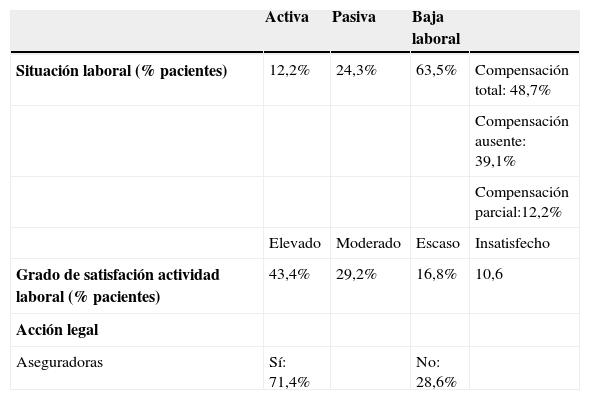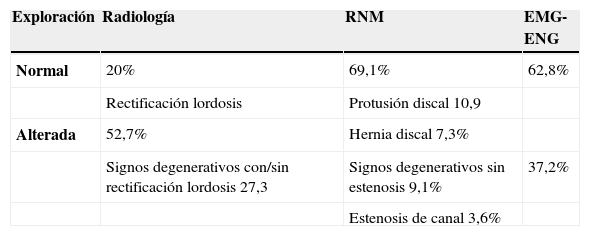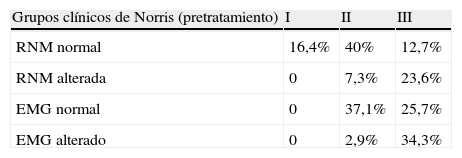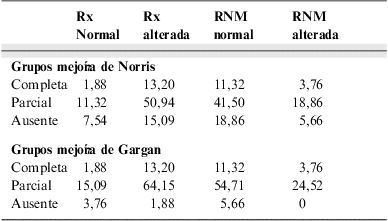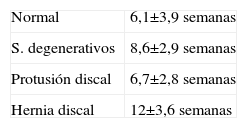El síndrome de latigazo cervical constituye un problema sociosanitario creciente; los objetivos planteados son: 1) establecer las posibles relaciones entre factores clínicos, funcionales y psicosociales, y su influencia en la rehabilitación; 2) comprobar si las alteraciones observadas en las pruebas complementarias influyen en la magnitud de la clínica y resultado de la rehabilitación.
Material y métodosCiento quince pacientes con esguince cervical (por accidente de tráfico) acceden voluntariamente a formar parte del estudio; se analizan los síntomas y signos, rasgos psicológicos, elementos laborales y sociales y capacidad funcional (cuestionarios de Occhipinti y Northwick). Las determinaciones se efectúan antes y después de un programa de rehabilitación, evaluándose mediante las escalas de Norris y Gargan. En 55 pacientes se valora la resonancia magnética nuclear, radiología y estudio neurofisiológico.
ResultadosNo existe una relación clara entre la severidad de los síntomas y los signos físicos, excepto en la fase inicial (p<0,05). La alteración funcional es proporcional a la intensidad del trastorno clínico (p<0,001). Existe cierta contribución de los rasgos psicosociales en la intensidad del dolor referido y restricción funcional (p<0,05). La gravedad del trastorno se relaciona con un tratamiento más prolongado (p<0,01) pero no hay diferencia significativa del resultado del tratamiento en los tipos clínicos. La capacidad funcional no se ve afectada en mayor grado ante alteraciones en las pruebas complementarias.
ConclusionesLos factores analizados parecen ser predictivos de la duración del tratamiento pero no del resultado del mismo. La cronicidad del dolor y la discapacidad parecen ser independiente de las alteraciones evidenciadas en las pruebas complementarias.
Whiplash syndrome constitutes an increasing sociosanitary problem, the objectives are: 1) To establish the possible relationships between clinical, functional and psychosocial factors and their influence on rehabilitation; 2) To check if the alterations observed in the complementary test influences the magnitude of symptoms and rehabilitation outcomes.
Subjects and methods115 patients with cervical sprain (because of a traffic accident), voluntarily agree to take part of the study, symptoms and signs, psychological features, occupational and social factors and functional capacity are analized (Occhipinti and Northwick questionnaires). Determinations are carried out before and after a rehabilitation program, beging evaluated by Norris′scales and Gargan. In 55 patients MRI values, radiology and neurophysiological study are valued.
ResultsA clear relationship doesn′t exist between the severity of the symptoms and the physical signs, except in the initial phase (p<0.05). Functional alteration is proportional to the intensity of the clinical disorder (p<0001). Certain contribution of the psycho-social features in the intensity of referred pain and functional limitation (p<0.05). The severity of the disorder is associated with longer treatment (p<0.01) but there is no significant difference of the outcome of the treatment in the clinical types. The functional capacity is not affected in major degree in view to changes in the tests.
ConclusionsThe analyzed factors seem to predict the duration of treatment but not the outcome of the same one. The chronic pain and the disability they seem to be independent from the alterations demonstrated in the complementary tests.
Artículo
Comprando el artículo el PDF del mismo podrá ser descargado
Precio 19,34 €
Comprar ahora













